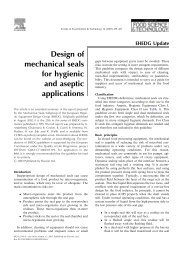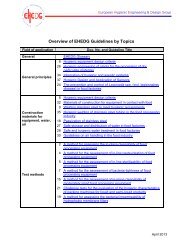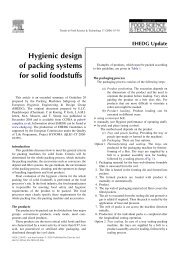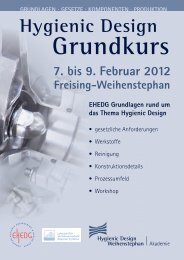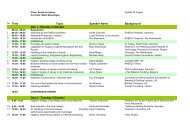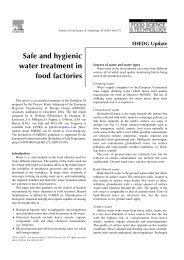Yearbook 2013/2014 - ehedg
Yearbook 2013/2014 - ehedg
Yearbook 2013/2014 - ehedg
Create successful ePaper yourself
Turn your PDF publications into a flip-book with our unique Google optimized e-Paper software.
European Hygienic Engineering & Design Group<br />
Effective tank and vessel cleaning:<br />
How different systems can help meet today’s demands<br />
Continuously developing tank cleaning technology with the aim of improving effectiveness and<br />
efficiency will help to reduce the required amount of energy and media.<br />
Falko Fliessbach, GEA Breconcherry, e-mail: falko.fliessbach@gea.com, www.gea.com<br />
Ever higher demands for process hygiene, combined with<br />
significantly increased costs for the energy required to<br />
heat up and convey cleaning media and long downtimes,<br />
are typical challenges for many production plants. It is<br />
therefore logical to critically analyse the cleaning processes<br />
in production plants to determine and exploit the potential<br />
for optimisation. Developing tank cleaning technology to<br />
improve effectiveness and efficiency will help to reduce<br />
the required amount of energy and media, and increase<br />
hygiene in the plant environment.<br />
Cleaning components are used for cleaning in various<br />
production plants in the food, beverage, pharmaceutical<br />
and chemical industries. They allow the cleaning of tank<br />
vessel and reactor surfaces – irrespective of whether they<br />
are in contact with product or not – to be integrated into<br />
the process. Cleaning media such as water, detergents<br />
or disinfectant solutions are applied to soiled surfaces.<br />
Depending on the application (i.e. whether vertical or<br />
horizontal tanks with or without internal fittings are to be<br />
cleaned and what type of residues are to be removed),<br />
various types of cleaning devices lend themselves to be<br />
used more effectively in some situations than others.<br />
Users typically want answers to the following questions:<br />
• What is the difference between the systems on the<br />
market?<br />
• Which system is the most effective and the most<br />
economical for my type of application?<br />
• Who has the expertise to advise me and develop the<br />
best solution?<br />
The most popular systems on the market and details<br />
about their technical characteristics and performance<br />
capabilities are introduced below. Special processes also<br />
are described.<br />
Three groups of cleaner types are distinguished:<br />
• Static cleaners<br />
• Rotating cleaners<br />
• Orbital cleaners<br />
Static cleaners<br />
Static cleaners, also known as spray balls, are available with<br />
various spray patterns: up only, down only or 360°, in various<br />
sizes and with different capacities (Figures 1 and 2). Spray<br />
patterns that direct liquid “up” are ideally suited for tanks<br />
without internal fittings, because the full amount of cleaning<br />
solution can be applied directly to the tank cover and the<br />
tank wall. “Down” spray pattern cleaners are best utilised for<br />
tanks that are open at the top, and “360°” spray patterns are<br />
designed for tanks with internal fittings. Depending on the<br />
application, the spray ball requires flow rates in the range<br />
of 30-50 litres per minute per metre of tank circumference<br />
to work efficiently. Spray balls are usually available with a<br />
threaded connection or pipe clip. Using spray balls for the<br />
cleaning of tanks with internal fittings is recommended<br />
only if large parts of the tank can be cleaned by wetting<br />
all surfaces. If this is not the case, other cleaning devices<br />
should be selected.<br />
Figure 1. Different types of spray balls.<br />
Figure 2. (a) Spray pattern “Down”; (b) Spray pattern “Up”; (c)<br />
Spray pattern “360°.”



